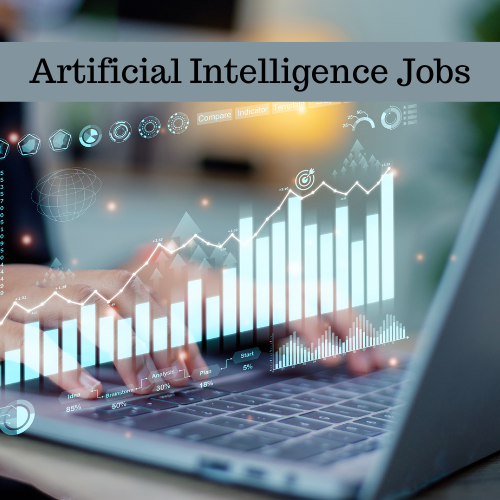Last Updated on 12 months by studentliveinfo
Table of Contents
Artificial Intelligence Jobs in 2024
The field of Artificial Intelligence (AI) is huge and fast evolving, offering several perspectives and opportunities across a wide range of sectors. Artificial intelligence is being used in a variety of fields, including healthcare, banking, education, transportation, and entertainment.
AI is projected to have a transformational impact on how we live and work as technology advances. Ethical and societal factors, on the other hand, will be critical in guaranteeing responsible AI development and implementation.
The development of computer systems that can do tasks that normally require human intelligence is referred to as artificial intelligence (AI). These tasks include learning, thinking, problem solving, natural language comprehension, perception, and speech recognition. Narrow AI (also known as Weak AI) and General AI (also known as Strong AI) are the two broad categories of AI.

AI applications are numerous and have a wide range of impacts, including healthcare, finance, education, transportation, and entertainment. While artificial intelligence has the ability to enhance efficiency and solve complicated problems, it also brings ethical and societal concerns, such as job displacement, algorithm bias, and the possible misuse of modern technologies. Researchers and politicians are working hard to overcome these issues in order to ensure the responsible and ethical development of AI systems.
Machine Learning Engineers
Machine Learning Engineers create and implement algorithms that allow machines to learn from data and make judgements. They work on natural language processing, computer vision, and recommendation systems, among other things.
A Machine Learning Engineer is a specialist in the design, implementation, and maintenance of machine learning (ML) systems and models. This position combines computer science, data science, and artificial intelligence. Engineers who work on machine learning algorithms and models help machines learn from data and make judgements or predictions.
- Identify and comprehend business problems that can be solved using machine learning approaches.
- Data collection entails gathering and preprocessing data in preparation for training machine learning models. Cleaning and converting data to make it appropriate for analysis may be required.
- Feature Engineering is the process of selecting and engineering useful data characteristics that will be used by machine learning algorithms.
- Model Development include creating and deploying machine learning algorithms and models. This includes selecting appropriate algorithms, fine-tuning parameters, and performance optimisation.
Data Scientist
Data scientists analyse and understand large datasets to help businesses make decisions. They extract insights and patterns from enormous amounts of data using statistical models, machine learning, and data analysis technologies.
A Data Scientist is a professional who uses statistics, mathematics, programming, and domain knowledge to analyse large databases and derive important insights. A Data Scientist’s position is critical in creating data-driven decisions and solving business problems.
- Problem Definition: Collaborate with stakeholders to identify business issues that can be solved using data analysis.
- Data Collection: Gather and collect important data from a variety of sources, ensuring that the data is clean, complete, and suitable for analysis.
- Exploratory Data Analysis (EDA): Use exploratory data analysis to learn about the structure and trends in the data. This entails gaining insights through the use of statistics and visualisation tools.
- Feature Engineering is the process of selecting and engineering relevant features from data that may be utilised to develop predictive models.
- Model Development: Create and deploy machine learning models to address specific business issues. Regression, classification, clustering, and other statistical and machine learning techniques may be used.

AI Research Scientist
AI research scientists undertake research in order to enhance the field of artificial intelligence. They create new algorithms, improve existing models, and contribute to the scientific knowledge of artificial intelligence. A professional who specialises in conducting research to enhance the subject of Artificial Intelligence (AI) is known as an AI Research Scientist.
This role entails investigating new algorithms, creating novel models, and contributing to the scientific knowledge of AI. AI Research Scientists often work in university institutions, research laboratories, or industry R&D departments.
- Research Planning: Outline the problems or difficulties to be tackled within the AI area, as well as the research aims and objectives.
- Review of the Literature: Stay up to date on the most recent research papers, publications, and breakthroughs in AI and related subjects.
- Design and development of unique algorithms and models that contribute to the evolution of AI technology. This could include investigating cutting-edge approaches in machine learning, deep learning, natural language processing, computer vision, and other areas.
- Plan and carry out experiments to validate theories, test new models, and assess their performance on various tasks.
Computer Vision Engineer
Computer vision engineers design methods and systems that allow computers to interpret and understand visual information from the outside world, such as photographs and videos. A Computer Vision Engineer is a specialist in the design and implementation of computer vision systems.
Allowing machines to comprehend and make judgements based on visual input, such as photographs and movies, is what computer vision is all about. These engineers work on picture and video recognition, object detection, facial recognition, driverless cars, and augmented reality, among other things.
- Problem Definition: Work with stakeholders to establish and comprehend the computer vision issues that must be addressed.
- Data collection include gathering and preprocessing visual data sets in preparation for training and testing computer vision models.
- Picture Processing: To prepare data for analysis, use picture enhancement, segmentation, and feature extraction techniques.
- Feature Engineering is the process of selecting and engineering useful features from visual data for use by computer vision algorithms.

Engineer in Natural Language Processing (NLP)
NLP engineers work on systems that can understand, interpret, and produce human language. They work on chatbots, language translation, and sentiment analysis, among other things. A Natural Language Processing (NLP) Engineer is a person who develops and implements systems that allow computers to read, interpret, and synthesise human language. NLP is a branch of artificial intelligence (AI) concerned with the interaction between computers and human language.
- Problem Definition: Collaborate with stakeholders to describe NLP challenges and application requirements.
- Data Gathering and Preprocessing: Gather and preprocess textual data sets for training and testing NLP models.
- Text Preprocessing is the cleaning and preprocessing of text data, which includes activities such as tokenization, stemming, and lemmatization.
- Feature Engineering: Select and engineer relevant features from text data that NLP systems can use.
- Model Development include creating and implementing NLP algorithms and models. This could include both traditional NLP techniques and contemporary approaches based on machine learning and deep learning.
- Named Entity Recognition (NER): Create systems that can identify and classify entities in text (for example, names, locations, and organisations).
Robotics Engineers
Robotics engineers develop, construct, and maintain robotic systems. They could work on industrial robots, drones, or self-driving cars, combining AI technologies to enable intelligent and autonomous behaviour. Robotics engineers are individuals who develop, construct, and maintain robotic systems.
These engineers construct devices that can do tasks autonomously or semi-autonomously by combining mechanical engineering, electrical engineering, computer science, and control engineering. Robotics is a diverse field, and Robotics Engineers frequently work on applications such as industrial automation, medical robotics, autonomous vehicles, and drones.
Design and plan the entire architecture of robotic systems, taking into account mechanical, electrical, and software components.
- Mechanical Design: Create the physical structure and components of robots while taking materials, kinematics, and dynamics into account.
- Electrical Design: Create and implement robot electrical systems such as sensors, actuators, and control systems.
- Programming is the process of creating software and control algorithms that allow robots to do certain jobs. C++, Python, and ROS (Robot Operating System) are examples of programming languages that can be used.
- Sensor Integration: Combine numerous sensors, such as cameras, lidar, and IMUs (Inertial Measurement Units), to allow robots to see and interact with their surroundings.
AI Product Manager
AI product managers are in charge of the creation of AI-based products. They work with cross-functional teams to establish product strategies and ensure that AI solutions are aligned with business objectives. An AI Product Manager is a professional who oversees the creation and management of artificial intelligence (AI) products or services.
This position necessitates a unique blend of technical expertise, business savvy, and strategic thinking. AI Product Managers collaborate closely with cross-functional teams comprised of data scientists, engineers, designers, and business stakeholders to bring AI technologies to market.
- Product plan: Define the overarching plan and vision for AI-powered products, ensuring that they are in line with company objectives and market demands.
- Market Research: Conduct market research on AI products to better understand customer needs, industry trends, and the competitive landscape.
- Collaborate with stakeholders to gather and prioritise product requirements, taking into account both technical and business perspectives.
- Create and present a product roadmap detailing major milestones, features, and timescales for the development of AI products.
- Cross-Functional Collaboration: Collaborate closely with data scientists, engineers, designers, and other teams to ensure the product plan is successfully executed.
- Data Privacy and Ethics: Address and integrate concerns about data privacy, security, and the ethical application of AI in product development.
AI Ethicist
As AI technologies create ethical concerns, there is an increasing demand for people who can handle the ethical implications, biases, and societal ramifications of AI. AI ethicists aim to ensure that AI development and deployment are responsible and ethical.
A professional that focuses on the ethical implications, societal impact, and responsible development of artificial intelligence (AI) and machine learning (ML) technologies is known as an AI Ethicist, also known as an AI Ethics Researcher or AI Ethics Specialist. As AI advances, ethical considerations become increasingly crucial in ensuring that AI systems are developed and deployed in ways that are consistent with human values such as justice, transparency, and respect for individuals’ rights.
- Contribute to the creation of ethical frameworks and guidelines for the responsible application of AI technologies.
- Policy Advocacy: Work with legislators, industry stakeholders, and the general public to lobby for AI-related policies and regulations.
- Assess the ethical risks and implications of AI systems, such as potential biases, discrimination, privacy concerns, and societal impact.
- Algorithmic Fairness: Assess and address fairness and equity issues in AI algorithms to ensure they do not perpetuate or exacerbate existing prejudices.
- Transparency: Advocate for AI system transparency, such as making algorithms more comprehensible and interpretable to consumers.
- Privacy Protection: Address privacy risks in AI applications linked to data collection, storage, and processing.
AI Software Developer
AI software developers design and maintain AI and machine learning-based software applications. They could be working on new solutions or integrating AI into current applications.
It’s crucial to remember that the field of artificial intelligence is evolving, and new career categories may develop as technology advances. Furthermore, the demand for AI workers is not restricted to technology firms; industries such as healthcare, banking, and manufacturing are increasingly adopting AI into their operations, resulting in a wide range of career opportunities.
Following industry news, attending conferences and workshops, and connecting with people in the area are all good ways to remain up to date on the newest developments and career possibilities in AI. AI-related job vacancies can also be found on online platforms such as job boards, professional networks, and business career pages.
Collaboration with stakeholders is required to describe the problem or task that AI can address within a software application.
- Algorithm Selection: Based on the application’s requirements, select relevant machine learning algorithms or AI techniques.
- Data Preparation entails gathering, preprocessing, and cleaning data in order to train and test machine learning models.
- Model training include creating and training machine learning models with libraries and frameworks such as TensorFlow, PyTorch, scikit-learn, and others.
- Feature Engineering is the process of selecting and engineering relevant features from data in order to improve the performance of machine learning models.
- Integrate AI components into the entire software architecture to ensure smooth functionality.



0 Comments